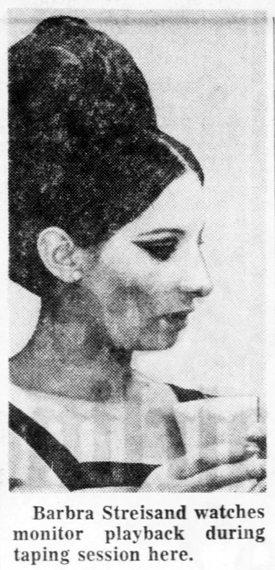
January 25, 1966
By HARRY HARRIS
Philadelphia Inquirer
MOST TV programs look as if they were stamped out by robots, but what happened at the Philadelphia Museum of Art all night Saturday and all day Sunday proved that specials like CBS’ March 30 “Color Me Barbra” are accorded plenty of tender, loving care.
 To put on a reel nine minutes of a sequence that will occupy 19 in the hour-long program with which super-singer-actress-comedienne Barbra Streisand hopes to duplicate the rating, critical kudos and multiple Emmy awards lavished on her first special, last season’s blockbuster “My Name Is Barbra,” a New York task force, plus local reinforcements, labored virtually nonstop from 7 P. M. Saturday to 8:45 P. M. (12 hours behind schedule!) Sunday.
To put on a reel nine minutes of a sequence that will occupy 19 in the hour-long program with which super-singer-actress-comedienne Barbra Streisand hopes to duplicate the rating, critical kudos and multiple Emmy awards lavished on her first special, last season’s blockbuster “My Name Is Barbra,” a New York task force, plus local reinforcements, labored virtually nonstop from 7 P. M. Saturday to 8:45 P. M. (12 hours behind schedule!) Sunday.
Included were 25 technicians and 12 electricians, to work the three truckloads of specially-imported equipment; six supervisors, including co-producers Dwight Hemion, doubling as director, and Joe Layton, choreographer and “creator,” and exactly one performer — Miss Streisand. (Like the earlier “Barbra,” this show will be strictly solo.)
Operation Art Museum, to tape the one-woman cast “singing” two songs, “Gotta Move” and “Yesterdays” (pre-recorded in New York last week at an all-night session that ended Friday at 4:15 A.M.) and wearing four striking costumes and coiffures while rushing from place to place and from century to century, had a detailed Friday-to-Sunday timetable.
The preliminaries went according to this circus shuttle-like schedule, but there were delays aplenty when it came time to beam actual program content via three huge microwave transmitters to WCAU-TV and, “for protection,” New York, where it was recorded on tape.
Thus, it was 9:42 P. M., some two hours late, after seven “takes,” that the first, approximately two-minute segment was completed and Miss Streisand left for a costume change while the cameras began shooting close-ups of a couple of Arensberg Collection Legers.
IN COLOR monitors, the Legers looked beautiful. So did various other museum treasures, including a displaced-for-the-occasion Roualt.
The Parkway Parthenon was subjected to quite a bit of combobulation. Paintings and sculpture were moved from their customary spots, to facilitate camera movement or eliminate “blank spaces” on walls.
The ornate, “just right” Louis XVI room was one of many “off limits” according to terms of loans bequests, so furniture was shifted from various parts of the museum to the Louis XIV and Louis XV rooms.
For a striking transition from the latter, where Barbra, as, Marie Antoinette (this is a dream sequence with flash-backs from scenes to be taped in New York) hears the horrible sounds of guillotining, to the 20th Century Arensberg rooms, a postcard of a headless Picasso woman was blown up to gallery size and “hung."
Approximately a mile of cable snaked through the first and second floors of the museum. Control equipment and monitors were crammed into an Italian Renaissance room. Other monitors were outside the Arensberg rooms, incongruous companions for Rousseau primitives, and in one corner of the Great Hall.
The microwave transmitters, plus a microwave receiver, so that Miss Streisand, Hemion and Layton, who are partners in the project, could see and hear playbacks of each “take,” filled the City Hall-facing East Window.
Some of the wooden barriers designed to prevent tumbling into the Great Hall were moved back, others moved entirely out of sight.
Several tables just off the court were heaped high with sandwiches, coffee, soft drinks, apples, and pastry, to furnish sustenance for the crew during the long, long night.
(The star, however, banqueted on such exotic fare as stuffed derma, onion soup, pickled tomatoes and chocolate ice cream.)
There were no horrendous mishaps, although about 12:30 A.M. a camera smacked BANG! into a Zadkine wood sculpture.
Hobart Williams, assistant to museum director Dr. Evan H. Turner, who was out of town, often looked perturbed, but seemed consoled by the fact that “a financial agreement,” a phrase he wouldn't elaborate on, included extensive insurance.
WHY did Barbra & Co. pick this particular museum for coast-to-coast showcasing?
lt wasn‘t because of any special affection for Philadelphia. Miss Streisand confessed during a between-shots lull, even though her two Broadway shows, “l Can Get It for You Wholesale,” which starred her husband, Elliott Gould, and “Funny Girl,” received tryouts here.
(She does admit a fondness, however, for Philadelphia's “antique shops.”)
“It just happens to be a beautiful museum,” she said.
Because the strikingly different aspect of the new show will be the fact that it's in color, an art museum locale seemed a “natural.”
Several other prospects were considered, including museums in Brooklyn and Washington, but Philadelphia got the nod because the physical layout seemed best suited to the contemplated treatment.
Miss Streisand, whose OK was required, was especially impressed by the imposing Great Hall stairway.
Although she never visited the museum while performing here (“When you're rehearsing,” said Gould, “you never get out of a radius of one block!”), she came three times to “case” the place before taping began.
A museum buff in New York, where she lives only a few blocks from the Museum of Natural History, she's a frequent Metropolitan Museum of Art visitor. Her own preference in paintings? Well, the Goulds own 15 Monets—Jason, not his grand-uncle Claude, a “brilliant” young impressionist — and a friend.
